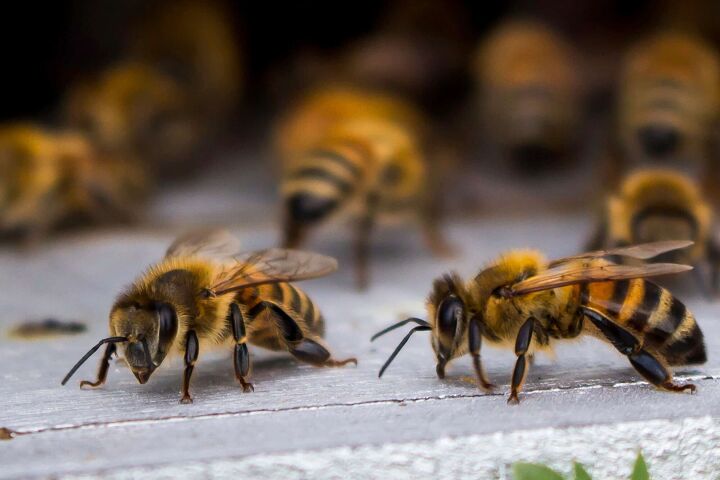How To Get A Bee Out Of Your House (Quickly & Easily!)

Unfortunately, it is often more challenging to get a bee out of your house than it is for them to get in. Bees can infiltrate your home by crawling into spaces that are less than half their entire size. Having a bee in your house can be a major cause for concern, especially if you have small children pets, or inhabitants that are allergic to bees.
Cover and trap the bee with a cup or bowl, cover it with paper, and release it outside. Make a mixture of 3 tablespoons of water and 1 tablespoon of sugar in a jar, seal it, and punch a hole in the top. Wait for a bee to enter the trap, then release it outdoors 10 feet away from your house.
Using one of the methods outlined below, you can effectively remove the bee from your home without any risk of being stung in the process.
Do You Need to Hire Movers?
Get free, zero-commitment quotes from pro contractors near you.

Trapping the Bee in a Container
The first option you have for getting a bee out of your house involves using a container to trap it.
Step 1: First, grab either a cup or bowl.
Choosing one that is clear will often make it much easier, but is not entirely necessary. Also, a plastic bowl or cup will reduce the risk of damaging your walls or windows due to its lower weight. However, nearly any type of container you have laying around the house can work.
Step 2: Catching the bee.
Once you have your container, make sure that you are wearing long pants and a long-sleeve shirt. You want your body to have the maximum coverage to reduce the likelihood of being stung. Then, watch the bee closely and when it lands on a smooth, flat surface in your home, hold the container in one hand and slowly and carefully bring it towards the bee. Once you are within six to twelve inches, increase speed and cover the bee with the container, trapping it inside.
Quick Tip: If the bee lands on a carpeted surface, do not attempt to trap it. Wait until it lands on a smoother, more solid material.
Step 3: Cover the trapped bee.
With the bee trapped inside your container, you need to grab a cover for it. If you’re using a bowl, an envelope, a piece of thick paper, or folded newspaper make effective covers. If you’re using a cup, opt for a magazine or notecard. Regardless of what you choose, you want the cover to be somewhat thin.
Once you’ve chosen the cover, slip it between the lip of your container and the surface the bee landed on. Move slowly so that the bee is directed above the cover and is positioned between it and the inside of the container. With the cover successfully under your container, the bee is officially trapped inside.
Step 4: Release.
At this point, you can release the bee outside roughly ten paces away from your house. Make sure that you run quickly back into your house afterward to avoid being stung or the bee trying to come back inside.
Using Sugar Water to Get Rid of Bees
Since bees are attracted to sweet flavors, such as the nectar they get from flowers, sugar water can be an effective way to lure and trap the bee. Follow the steps outlined below to get rid of your bee problem using sugar water.
- Combine sugar and water. Mix together three teaspoons of water with roughly one teaspoon of traditional white sugar. You can use a blender to mix it or whisk quickly by hand.
- Place the mixture into a jar. Using any size jar, place about a half a cup of the sugar and water mixture inside. The jar can be plastic or glass, but the lid used to secure it must be made of plastic. Pasta sauce, peanut butter, or jelly jars make excellent choices.
- Seal the jar. With the sugar and water mixture inside the jar, seal it up by placing the lid on top.
- Punch a hole in the lid. Using a knife, drill, or some other tool, create a hole in the center of the lid. The hole should be roughly the same diameter as your pinky finger. It is crucial that the hole is kept small so that the bee can easily crawl in but will have difficulty escaping back out.
- Wait for the bee to enter the jar. At this point, you must wait for the bee to enter the jar before you can proceed.
- Take the jar outside. Once the bee gets into your jar, it may drown in the sugary mixture. If so, take the jar outside, remove the lid, and dispose of the contents in an open, grassy area away from your home.
- Set the bee free. If the bee is still alive inside of your jar, quickly cover the hole with a piece of duct tape or your thumb. Then, go outside and away from your home to unscrew the lid and release the bee. Carefully pour out the liquid inside to avoid it getting on the bee. When it flies out, run back inside your house and firmly close the door behind you.
If you don’t have much luck with attracting the bee to your sweet concoction, you may need to try using filtered water other than tap water. Although it may sound silly, the bee taking up residence in your home may prefer a different quality of water.
Let the Bee Leave on Its Own
The final option you have for getting a bee out of your home in a nonviolent manner is to allow it to leave on its own. In fact, opening the windows or a door in your home is often the easiest way to remove bees that are flying around inside. They are attracted to the light outside and will often fly towards it on their own.
Start by opening up your windows and removing the screens, if necessary. If you do have to remove the screens, be sure to place them nearby the window so they don’t get mismatched when it’s time to put them back. Also, raise your blinds and/or curtains to allow for an easy exit for the bee.
Quick Tip: If it’s dark outside, turn on a light directly outside your window and shut off the lights inside. This will help draw the bee out of the window. Once it exits, close the window immediately.
In addition to opening your windows, opening any doors to the outside and keep them propped open. The bee inside your home is going to be constantly looking for a way back to its hive and any flowers nearby. With your windows and doors open, this makes it much easier for the bee to find its way.
Keep a close eye on your open doors and windows to ensure that no birds or wildlife enter and immediately close them once the bee leaves.
Do You Need to Hire Movers?
Get free, zero-commitment quotes from pro contractors near you.

Related Questions
I have a bee in my house but I don’t see it anymore, what should I do?
If you didn’t see the bee leave your home, it has most likely flown away. However, you can keep your windows and doors open to ensure that it does leave. If it hasn’t exited, there’s no need to worry, as the bee will only survive inside your home, without a source of nectar and pollen, for about a day.
What do I do if I have bees behind my walls?
If you hear bees in your walls, you should call an exterminator immediately. Detecting bees within the walls of your home often means that you have a hive behind the wall.
How do I keep bees from nesting in my home?
Since bees can enter through very tight spaces, a great prevention technique is to seal any possible entries using durable materials, such as caulk or even a metal screen.Another option to keep bees away from the inside of your house is to make the exterior undesirable. To do this, you can apply treatment to your yard, reduce outdoor clutter, and move unused lawn equipment to your garage so they have fewer spaces to hide.
Related Guides

Jessica considers herself a home improvement and design enthusiast. She grew up surrounded by constant home improvement projects and owes most of what she knows to helping her dad renovate her childhood home. Being a Los Angeles resident, Jessica spends a lot of her time looking for her next DIY project and sharing her love for home design.
More by Jessica Stone


























![10 Most Dangerous Neighborhoods in Baltimore [Updated]](https://cdn-fastly.upgradedhome.com/media/2023/07/31/9075655/10-most-dangerous-neighborhoods-in-baltimore-updated.jpg?size=350x220)
